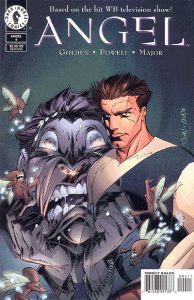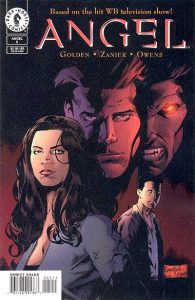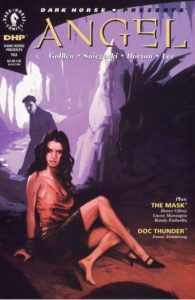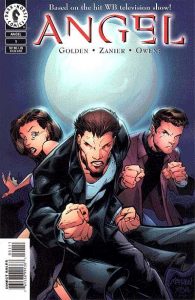Christopher Golden is arguably the elite “Buffy”/“Angel” spinoff writer, but the early issues of Dark Horse’s classic “Angel” series prove he’s not infallible. I assume he wasn’t given enough time to get a good feel for the Angel-Cordelia-Doyle dynamic, because Issues 1-7 – which comprise the entire Doyle era of the series – mostly rely on the parent show for us to feel anything for these characters. Maybe Glenn Quinn has one of those faces that doesn’t translate to an artist’s pencil, because he usually doesn’t look right. The best likeness comes in his very last panel, in Issue 6.
“Surrogates” (Issues 1-3, November 1999-January 2000)
The first “Angel” spinoff story feels rushed, and it almost certainly was, as it hit the rack a mere two months after the first episode aired. Issue 1 gives the vampire-with-a-soul’s backstory yet again; you gotta figure the target audience already knows the basics from “Buffy” or “City Of” (“Angel” 1.1). It spends less time establishing the Angel Investigations trio, so I relied on my knowledge from the TV show, but someone who didn’t get The WB or who lived overseas would feel thrown into the middle of things. Helping out those readers, it does repeat the TV show’s gag of Doyle sneezing and turning into demon-face when Cordy isn’t looking, but that adds to the feeling that Golden was pressed for time.
Christian Zanier (pencils) and Andy Owens (inks) are good at the general feel of the three leads – via postures and moody lighting – more so than likenesses.
“Surrogates” is a padded story about a fertility clinic run by a demon who can pass as a human woman. She uses surrogates to give birth to demon children, which she then takes from the birth mother, claiming the child is dead. Cordelia would soon find herself in this situation in Howard Gordon’s “Expecting” (1.12), but the timing of the stories is so close that I assume Golden and Gordon came up with the same idea independently.
2.5 stars

“The Changeling Wife” (Issue 4, February 2000)
In this entry, with Eric Powell filling in on art duties, Golden has a slightly better feel for the Angel Investigations dynamic, with Doyle and Cordy doing research at the office, and the latter complaining: “Where’s Rosenberg when you could use her hacking skills?” The rhythms fit with the TV show, if too generically. The story is about a guy who beats his wife, who is actually a demon.
3 stars

“Earthly Possessions” (Issues 5-7, March-May 2000)
Now we’re finally cooking, as Golden (with Tom Sniegoski co-writing the final two issues) and the Zanier/Owens team get comfortable in “Angel’s” L.A. stomping grounds. One oddity is that the plot starts off the same as “The Changeling Wife,” in that a man is beating his wife; the twist is the opposite of the previous story, as it’s the husband who is possessed. The yarn then shifts focus to an exorcist who is causing the possessions in the first place, all part of a money-making scam, which makes for a nice contrast with Angel’s philosophy of helping first and looking for payment second.

The best part of “Earthy Possessions” is that the comic’s world starts to get populated. Angel buys a book at Cobwebs Used & Rare books, owned by a man named Elijah, with whom our hero has a good rapport; he would’ve made an excellent TV character. And Kate, introduced in “Lonely Heart” (1.2), enters the picture as Angel’s uneasy policewoman ally.
In an approach that will be jarring and confusing to people who haven’t seen “Hero” (1.9), Doyle drops out of the story midway through Issue 6, and after a “one week later” tag, we see Cordy looking numb and sad. “Oh, Doyle, you had to be the hero,” she says.
For those who realize that Doyle’s death happened off-panel on the TV show and don’t require a recap, “Earthly Possessions” then turns into a nice grace note for Quinn’s character. His ex-wife Harry, seen in “The Bachelor Party” (1.7), lends her demonology knowledge to Angel’s takedown of the exorcist scammer, and everyone commiserates over the loss of their friend. “Parting Gifts” (1.10), where Cordy discovers she now has Doyle’s vision power, then takes place after this.
Doyle gets a decent send-off, but ultimately the comics give fans of the half-demon little to appreciate. I’m looking forward to getting more Doyle in my “Angel” novels re-read.
4 stars

“Lovely, Dark, and Deep” (“Dark Horse Presents” Issues 153-155, April-June 2000)
Brian Horton (pencils) and Paul Lee (inks) deliver excellent likenesses of Angel and Cordy in a simple black-and-white story that adds up to the length of one normal issue. Riffing on “The Blair Witch Project,” which was a phenomenon at this time, the tale – which features neither Doyle nor Wesley — finds Cordy taking a job on a handheld camera movie, where the actors are asked to improvise from a loose outline. The twist, which you’ll immediately guess, is that the monsters hunting Cordy and her co-stars are not men in costumes.
3 stars
Click here for an index of all of John’s “Buffy” and “Angel” reviews.

